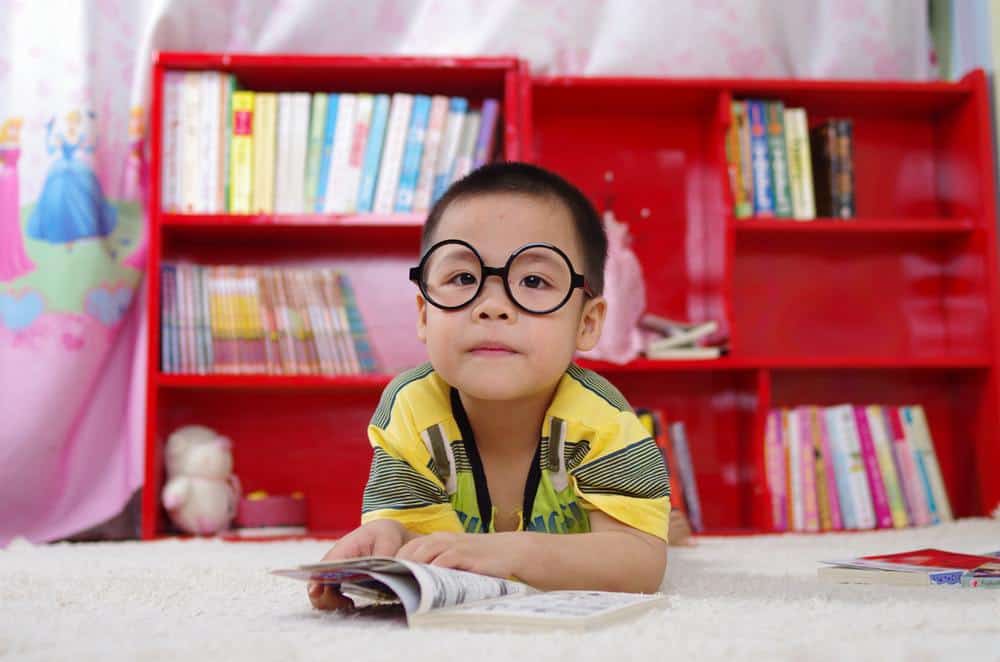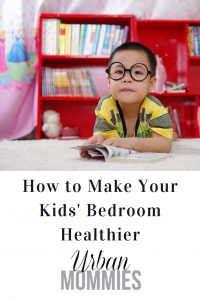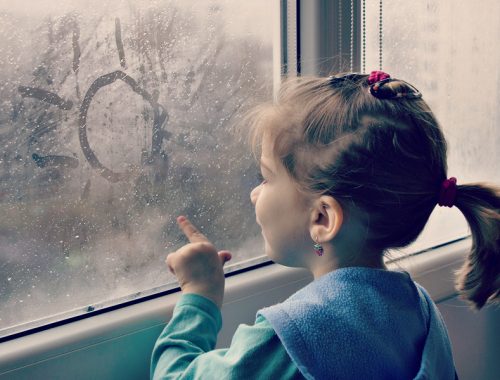Children of all ages treasure their bedrooms – it’s their refuge, their castle, their playroom, their private spot, whatever they want it to be. And they spend as much time there as they can. But is this space actually healthy for them? Kids’ rooms seem innocuous – a floor, four walls, a bed, desk, bookshelves and a closet. What’s unhealthy about any of that? You’d be surprised at the number of toxins and allergens that may be present and to which your child may unwittingly be exposed. We have some ideas how to make your kids’ bedroom healthier.That exposure can lead to negative health effects sooner or later. Read on to find out where the hazards are and how to avoid them and how to make your kids bedroom healthier.
Healthy Hardwood
Typically, the floor in kids’ rooms is covered in carpet. While this may help to soften the bumps of roughhousing, it’s actually an unhealthy option for your child’s bedroom. That’s because carpets are made from nylon, which is manufactured using petrochemicals and formaldehyde glues. Carpet underlay is also bound together with formaldehyde glues. These substances create a toxic chemical air quality issue.
The air quality problem is compounded when the formaldehyde glue in the carpet lining begins to break down, as it does naturally in older carpets. As the glues age and dry, the chemicals become airborne and are easily inhaled or ingested. The breakdown of formaldehyde in the air has been linked to nose and throat irritation, nervous system damage and cancer.
The other concern about carpets is that they attract dust. Studies have found that carpeted rooms have higher particulate counts (dust levels) than rooms with solid flooring. The airborne contaminants and the dust from carpets can be triggers for asthma. When you stop to consider that asthma in children has increased fourfold in the last 20 years, you realize how important it is to remove as many triggers in the home as possible. Removing carpets from your child’s room is one positive step that you can take.
If you are unable to get rid of the carpet in your child’s room, then vacuum it well. That means using a sealed HEPA (High Efficiency Particulate Air) filter vacuum cleaner. Anything less will only suck up all the dust, allergens, and particulates and pass the smaller allergy-triggering particles through the vacuum and out the other side – right back into your child’s room. So what type of flooring is best for a child’s room? Hardwood, bamboo and cork floorings are all good choices because when they are sealed with natural sealers, (cork and bamboo come presealed), or oiled, there is no chemical off gassing. They also are better for dust control. Carpets can hide dust, keeping allergens in the room. However, dust is visible on a solid surface floor and can be easily managed and removed.
Choose bamboo if you’re worried about the wear and tear of your child’s activities on a hardwood floor. Harder than any North American hardwood, bamboo holds up to abuse well. Cork flooring provides a softer surface. It’s tough, durable, spill-resistant and has some give. If you want to use throw rugs on any of the flooring, make sure they are made of cotton or jute and air them out frequently. This is one way how to make your kids bedroom healthier.
VOC Paint Dangers
Walls are one of the biggest areas of concern in your child’s room because both paint and wallpaper can present health hazards. Most paints contain VOCs (volatile organic compounds), which are toxic chemicals that enable the paint to stick to the wall and to be cleaned easily. VOCs are associated with a wide range of health effects, from eye, nose and throat irritation, headache and nausea to liver damage and cancer.
Children should not be present if you are painting with VOC paint. In addition, the room should be well-ventilated, using a fan to draw air out of the window so the VOCs are not spread throughout the house. VOC paint presents the greatest risk when it is wet. But even when the paint is dry, it will emit toxins for months to come.
Luckily, there is an alternative. Instead of VOC paint, parents can opt for low or no VOC paints. Almost every paint store now carries a version due to the demand. The only downside to low VOC paint is that it doesn’t come in dark colours.
Wallpaper, unfortunately, is not a good alternative to paint. That’s because the glues used to secure the paper to the wall are also toxic and, like paint, will off-gas for months even after the wallpaper has dried. Washable vinyl wallpaper is even worse because of the number of chemicals it contains, which also leach out over time. Your child is much better off without wallpaper in his room.
An even healthier option than low VOC paint is to use natural plaster over the drywall in your child’s room. Natural plaster helps regulate indoor humidity levels (controlling moisture helps control odours and potential mould growth) and offers a textural, tactile surface. Because these beautiful troweled finishes are safe and non-toxic, kids can help apply them.
Keep dust mites away
Desks, dressers and bookshelves. Furniture for kids’ rooms is often made from particleboard, which is glued together using formaldehyde glues. These pressed wood products will off-gas within the room. To remedy the health concerns, try moving to solid wood furniture. Solid wood is always the best option for health, and ultimately will endure the daily workout dished out by kids. If you can’t afford new furniture, look for antiques or unfinished wood that can be refinished to suit your child’s room. (Remember to use low VOC paints and finishes.) If you must stick with your particleboard furniture, seal it with a product such as AFM Safecoat, which is non-toxic.
Healthy Beds
Our children often sleep in hand-me-down single beds or old crib mattresses. But these old beds, and old pillows too, have a big problem – dust mites and their faeces, which are serious allergens. Addressing this is one way to solve the problem of how to make your kids bedroom healthier.
Dust mites prefer to live in dark, moist environments and feed upon their favourite food – dead skin cells. Old mattresses and pillows fit the bill nicely. In fact, the older the mattress and pillow, the larger the dust mite family.
The best solution is to buy a new mattress and box spring. Choose mattresses made of natural materials that inhibit dust mites and don’t off-gas, such as cotton futons and natural latex mattresses. Chemical free box springs are also available. Follow up with a natural latex pillow and organic cotton sheets.
If you just can’t afford this type of purchase, there are easy ways to rid your child’s old bed and mattress of the dreaded dust mites. Instead of providing the dark and moist environment that bed bugs like, provide a light, dry environment. Each day, get your child to pull back the covers during the day to allow the mattress, pillow and bedding to dry out. (Your kids will love not having to make the bed. And you will get over it in time.) When the bed dries out, the dust mites die off.
Periodically, you should also take the bedding and the mattress outside in the sun. The sun is a natural bleach and will air and dry out the mattress, sending the bed bugs scurrying. This simple remedy will reduce the allergy-inducing dust mite population dramatically. (It also gives you a chance to clean out whatever may be under your kids’ beds.)
Closet Organizing For Kids
Your child’s closet can be a virtual haven for allergens, such as mould, mildew and bacteria. With some simple steps, you can keep the closet and the health issues that come with it under control.
If your child is like mine, the bottom of his closet is packed with clothes – old gym clothes and assorted other dirty clothes, all damp and in need of a wash, together with outdoor shoes and sneakers, with some folded clean laundry thrown in for good measure. The moisture trapped in the bottom of a dark closet corner because of damp clothes provides an ideal place for mould and bacteria to flourish. The shoes harbour outdoor pollens and pesticides. The result: a musty, smelly closet filled with allergens.
There are several ways to tackle this mess. Kids don’t like to hang up their clothes, so try putting more shelves in the closet for them to use. Put the laundry hamper outside of the closet so the moisture from sweaty clothes can evaporate in the room instead. Keep shoes out of the bedroom.
At the same time, improve the air flow in your child’s closet by putting vents on the closet door or using bi-fold doors with louvres. The drying effects of air movement will help remove trapped moisture from the closet. If your child already has acute allergies, put a dryer vent at the top of the closet that vents outdoors. This, combined with a door vent at the bottom of the door, will create the maximum amount of airflow to take allergens outside.
Healthy Space Healthy Kids
Because of their rapid development and growing bodies, children absorb more toxins than we do as adults. We need to ensure that their bedrooms really are a safe and healthy sanctuary for them. Following some or all of these ideas of how to make your kids bedroom healthier will help you create a healthy space in which your child can grow.





[…] when you are a new parent, or if you have several children. Try as best you can to go green and healthy, but do what makes sense for your family. The smallest steps will add […]